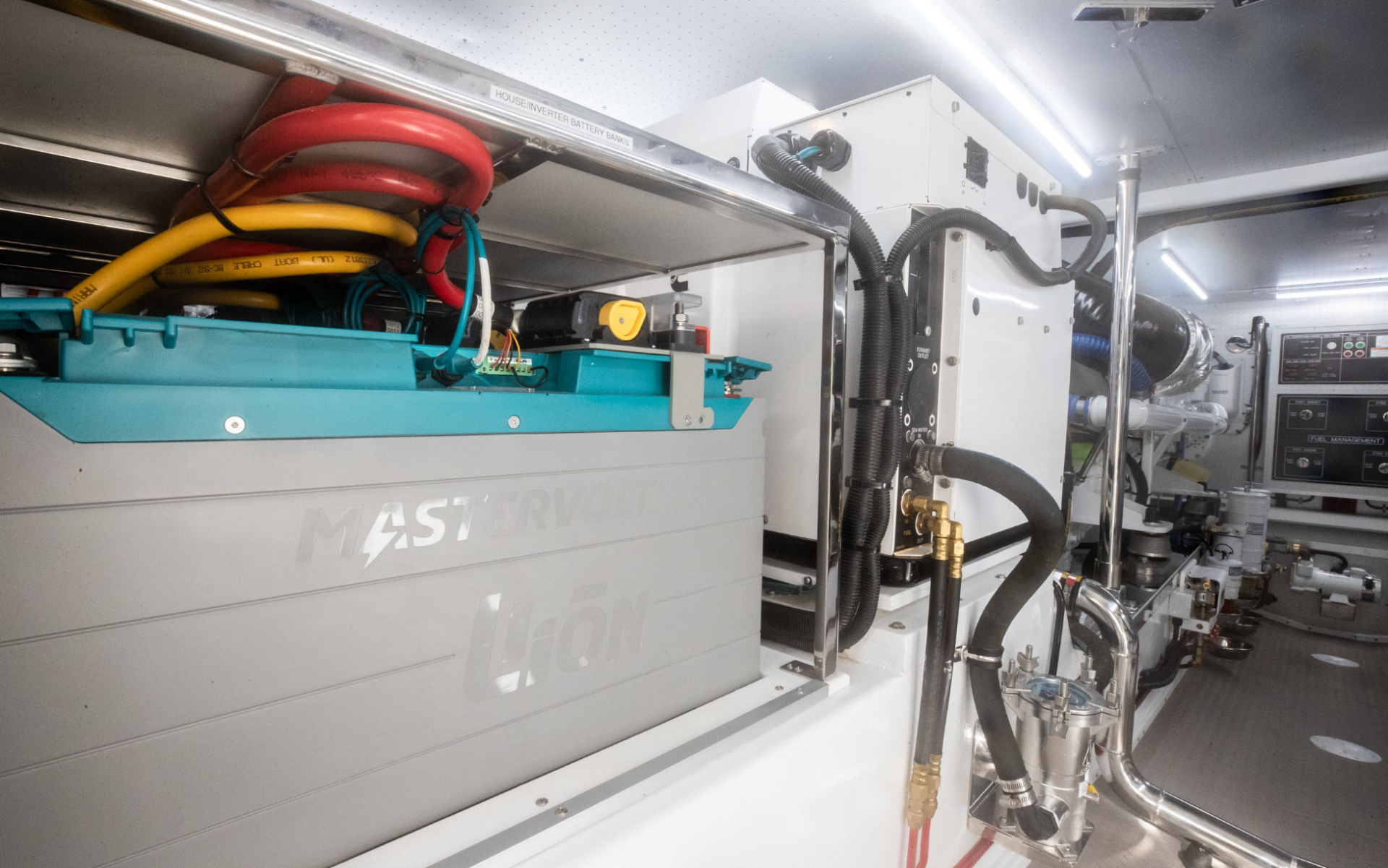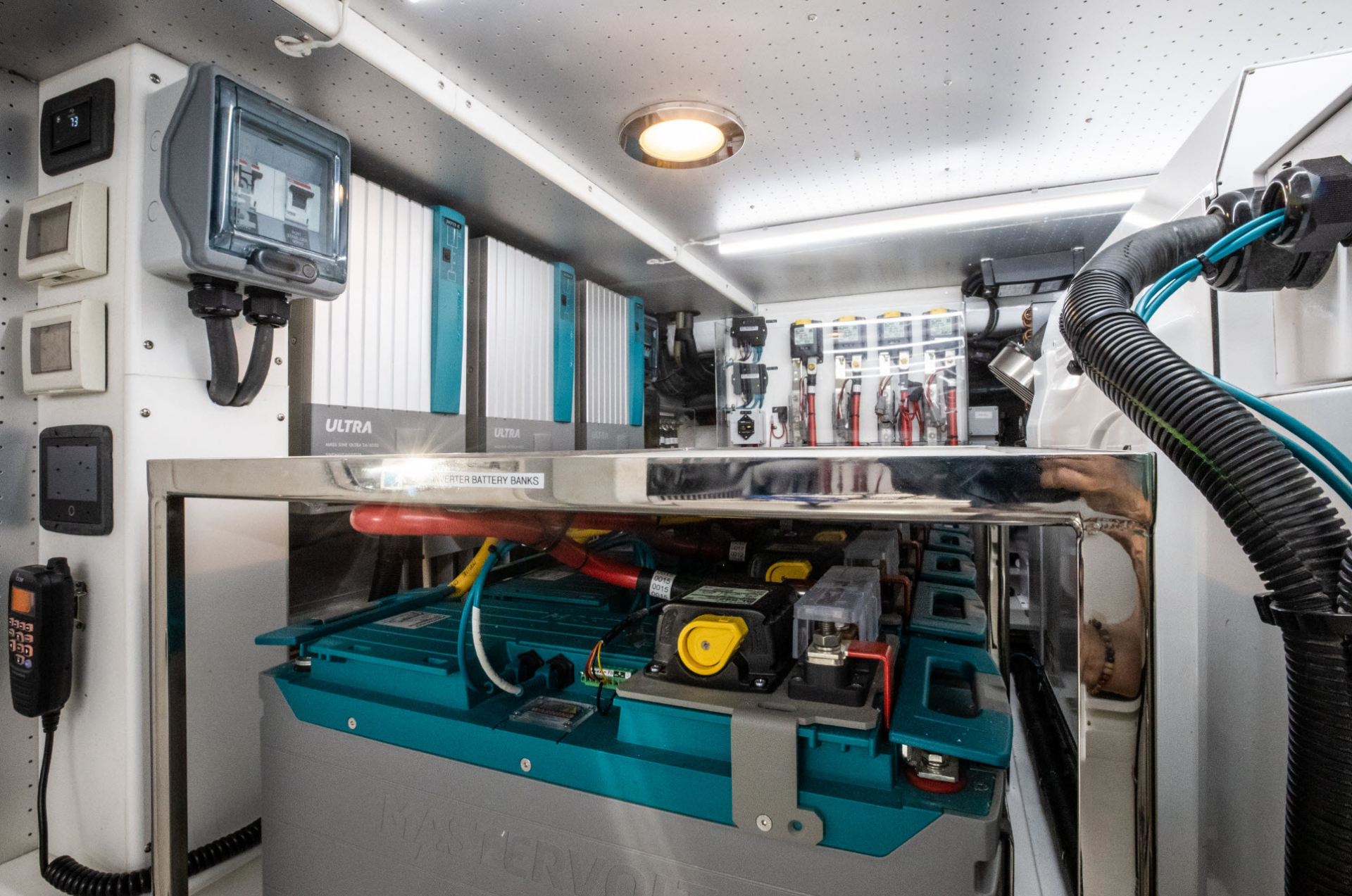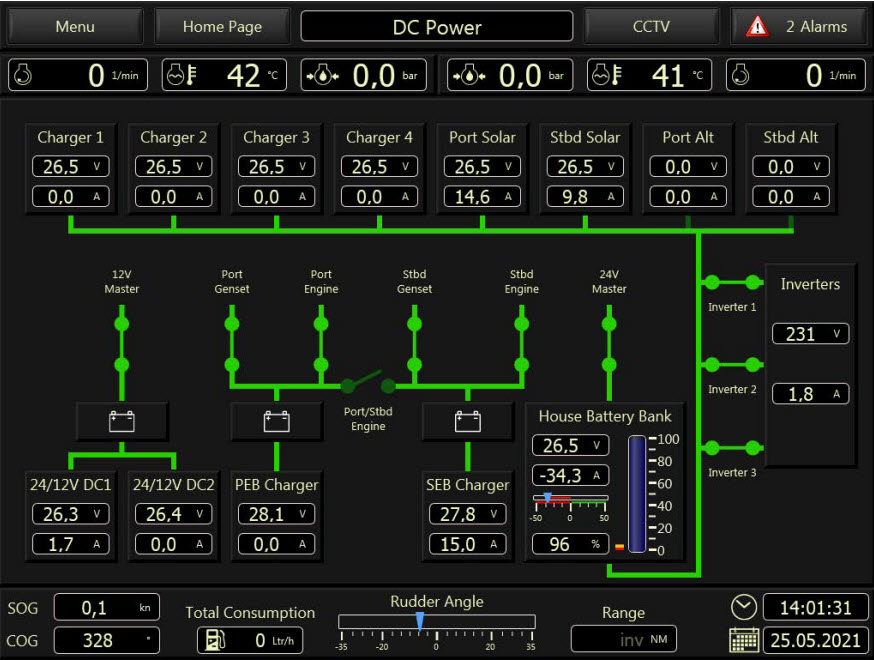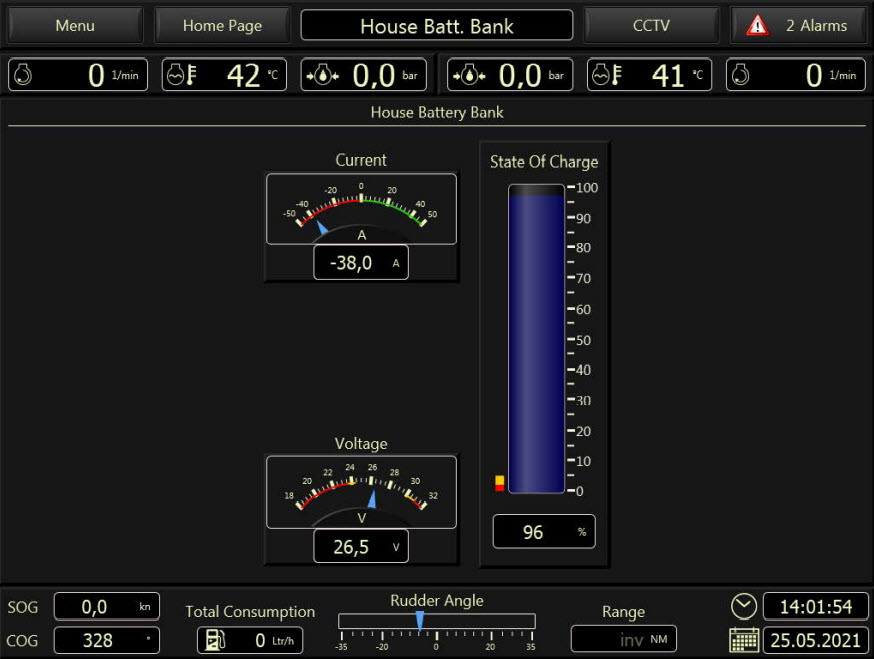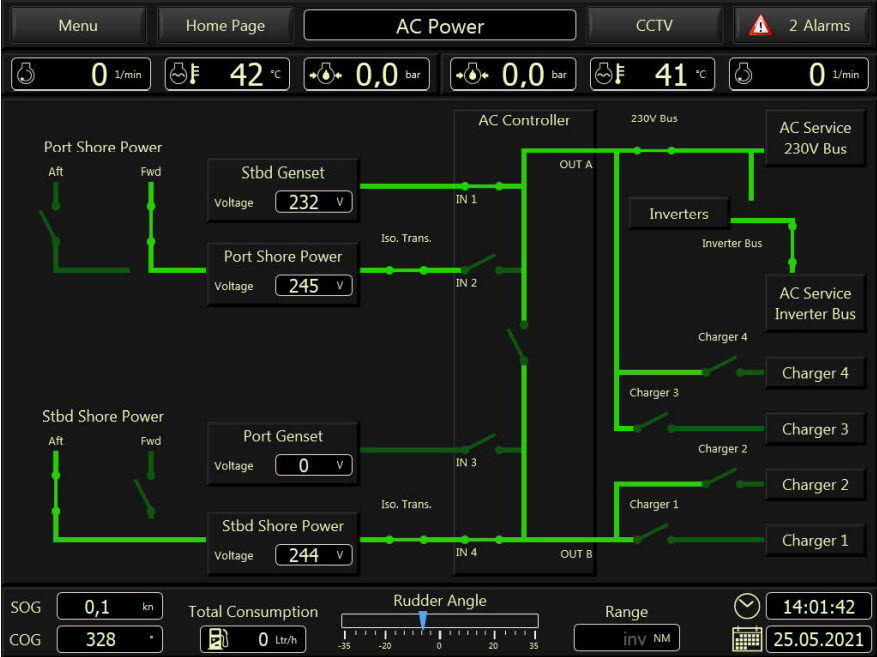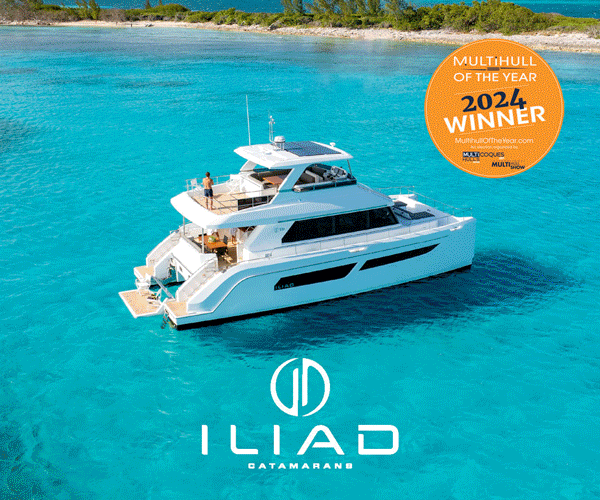Fleming 65 Lithium Battery Overview
Cruising the Gold Coast just got a little quieter. Hull #058 of the Fleming 65 was recently delivered to its new owner with a few changes to past models.
17 May 2022
Every Fleming built is unique, customised to the owner’s plans, preferences and requirements.
The company rarely introduce a new model, but rather continually improve and tweak each new Fleming based on owner feedback, a testing program and feedback from Tony Fleming’s own personal experiences.
Hull 058 represents a new step forward for Fleming, as it boasts an impressive list of standard equipment, including solar panels and lithium batteries.
Other options include a Twin Disc EJS Joystick system that pairs the controls of the powerful hydraulic bow and stern thrusters with the Quick Shift transmissions.
This allows the F65 to hold position and heading smoothly and effortlessly with automatic and precise proportional control of shaft speed and thrusters to match the conditions, whether waiting on a bridge to open or preparing the lines and fenders for docking.
Enjoy this video walk-through of Hull 058, then read about the benefits and installation of the lithium-Ion battery system.
It provides 1,000-amp hours capacity with the ability to be discharged much deeper to 20 percent state of charge, and then recharged from 20 to 100 percent state of charge, much quicker than standard AGM batteries.
There are three 100-amp chargers that work in combination or individually to manage shorepower draw and 12 kw of inverter capacity. In addition, there are two 200-amp brushless alternators for quick charging while underway and 1,430 watts of solar for silent charging at anchor.
SAFETY
There are many different types of Li-Ion batteries, but the only type Fleming use are Lithium-ion Phosphate (LiFePO4), which are said to be the safest chemistry. Other types have more energy in a smaller physical size, but are quite volatile – it’s these which have caught fire in cell phones.
The Lithium-ion Phosphate batteries are only slightly smaller than AGM, so there’s no space saving, but there is a significant weight saving – on a F65 the Li-Ion house bank is (204 kg lighter than the standard AGM bank.
Each battery has its own BMS (Battery Management System), its own fuse and an automatic safety switch – if the BMS senses that there is anything wrong, such as imbalance or overheat, it will automatically disconnect that battery from the bank.
Each battery is 24 volts, so if one battery is disconnected from the bank it won’t affect the voltage of the bank, only its capacity; the system still works with only one of five batteries connected.
The system has been designed so that all charging sources are on the same network and any battery can switch off a charging source if it’s not working correctly. The network includes all battery chargers, inverters, alternator regulators, solar charge controllers, DC-DC converters and instruments.
CHARGING
Standalone battery chargers and standalone inverters are preferred – these cost more and takes up more physical space than the combi inverter/charger type units but provides additional redundancy, cleaner power with no pass-thru issues/spikes.
It also makes it simple to control how much shorepower you’re using by simply turning the chargers on and off as required. On the Fleming 58 and F65, there’s three individual 100-amp chargers.
So, when using only one shore cord you just use one charger and when on two cords or genset you can run all three together for a faster recharge time. The F55 system has two 100-amp chargers; the Fleming 85 has four.
The biggest advantage of the Li-Ion system is the ability to recharge from 20 percent to 100 percent in around 3.5 hours, whereas AGM batteries can only be discharged to 50 percent and would take three times as long to recharge.
The Li-Ion batteries will accept a far higher charge rate and continue to accept it until they are 100 percent charged. All Fleming’s have two Delstar heavy-duty, brushless, 200-amp alternators. They’re controlled by external regulators which are connected to the battery management system and will provide 85+ amps each at idle engine RPM.
Fleming are seeing outputs of 200 amps from these alternators at cruising speed. So, you can recharge Li-Ion quickly when underway on short trips, as well as via the genset.
INVERTERS
The company have increased the inverter capacity and run a lot more loads from the inverters, the exceptions being aircon, oven, electric BBQ and water heater. Laundry appliances have successfully been run, as well as a watermaker via the inverters.
The Fleming 55 has a single 4,000-watt inverter, the F58 has two 4,000-watt inverters and the F65 has three inverters providing 12 kw.
Multiple inverters are stacked and operate as one unit which allows peak loads to be handled for short periods of time by using battery power – this is especially useful if there’s only one shorepower cord, or in areas which can only provide a single 16-amp supply, as it prevents nuisance tripping of the shorepower. There’s also an inverter by-pass system for redundancy.
On the F55 and F58, it’s only possible to have one genset with the Li-Ion house bank and whilst it’s possible to have Li-Ion and two gensets on the F65, we recommend a single genset and carry adequate genset spare parts.
The stacked inverters provide as much power as a second genset and squeezing in two gensets as well as all the electrical components takes up space, reduces accessibility, adds weight and increases heat.
CYCLE LIFE
Mastervolt claims that under ideal conditions, the batteries can be cycled 3,500 times – a cycle being a discharge to 20 percent and recharge to 100 percent, at 25 degrees Celsius.
Lifeline AGM claim their batteries will provide 1,500 cycles if only discharged to 50 percent state of charge. However, there are many variables and all batteries regardless of type are greatly affected by temperature.
All Fleming’s with Li-Ion batteries also have engine room aircon which is run whenever shorepower or genset power is available. The Li-Ion batteries are installed on a platform in the port aft corner of the engine room, with good spacing between each battery and a stainless-steel frame around them with a shelf over.
This provides additional storage space, but the primary purpose is to create an air tunnel around the batteries so the engine room aircon flows through to keep the batteries cool. Each battery has a pair of custom-made stainless-steel brackets securing it to the platform, and they sit within a grid and can’t move in any direction.
Controlling the engine room temperature also increase longevity of chargers, inverters and other components in the engine room.
The initial cost of the Li-Ion system is significantly higher, but even if the actual number of cycles is only 50 percent of what the manufacturer claims, they should still last 8+ years, if looked after.
So, in the long run it’s a cost-effective solution. We expect battery technology will continue to improve and become more economical by the time the systems require replacement. All battery data is logged, so depth of discharge, battery temperature,and charge rates can all be reviewed.
INDICATION
We include a Mastervolt touchscreen which shows all data on the Masterbus network. Fleming also feed that data into the Fleming First Mate Monitoring System so that the entire DC system can be viewed on a single page.
The AC page shows shorepower and genset power, voltage, frequency and current draw, and allows you to switch the shorepower circuit breakers on and off, as well as the 100-amp battery chargers.
The DC page shows house bank state of charge and all your charging sources including solar, engine battery chargers and the DC-DC converters.
Fleming also include a 4.3-inch touchscreen in the master cabin on all models; in addition to being an alarm repeater, this screen can also be used to control cameras, view the battery bank and start/stop the gensets. On boats with iPad integration, all Li-Ion system data is also included on the iPad.
SOLAR
To understand the advantage of solar it’s helpful to consider Standby DC load – the amount of current being drawn from the house battery bank under normal conditions, for example, no shorepower connected, no genset running, lighting switched on, refrigerator running and electronics are on.
For most F65s this is approximately 50 to 60 amps. During the day it can be higher and overnight it typically reduces to around 35 amps.
Ideally, the house battery bank capacity should be large enough to run these loads overnight without requiring a genset. With the 1,000 A/H Li-Ion system on the F65, the standby load is handled and the master cabin aircon can run overnight via the inverters, without requiring genset power.
The solar panels are also semi-flexible and bonded directly to the hardtop. These panels can be walked on and have a non-slip surface, but care must be taken not to drop things on them, such as tools.
The solar power option is slightly different on each model and requires a hardtop as well. The F55 solar option is 690 watts, which in perfect conditions would produce 23 amps charge current.
The F58 has 830 watts (28amps), F65 has 1,430 (49 amps), Fleming 85 has 1,800 watts (62 amps) – in reality you won’t see these figures, it will be slightly less and very dependent on the brightness and angle of the sun, and will also be reduced if there’s any shading.
The company try to reduce the effect of shading by using multiple charge controllers and have had good results on the last two F65’s with this system. So, if you are anchored on a nice sunny day, not running the genset, your standby DC load is 50 amps, but the solar is providing 20 amps of current, reducing your standby load to 30 and increasing the time you have before needing to run the genset.
OTHER FACTORS TO CONSIDER
Humphree Stabilizers – The company have several new Fleming’s (all models) with Humphree DC electric stabilisers, and are pleased with the results.
Humphree stabilisers work well the Li-Ion option, as it gives you the ability to have stabilisation at-rest without having to run a genset. The length of time is dependent on the conditions and size of the battery bank, but customers enjoy the benefits of stabilisation at rest overnight without running a genset.
Insulation – Our double-glazing option and dealer-installed window films such as V-Kool (or similar) assist greatly in reducing aircon load and making for a more efficient yacht. This makes a significant difference, especially for customers wishing to run aircon via the inverters.
Enjoy this customer video below from the owners of Freja who have owned both a F55 and a F65 now from Fleming Yachts Australia.
More information about Lithium Batteries aboard the Fleming 65 here.




